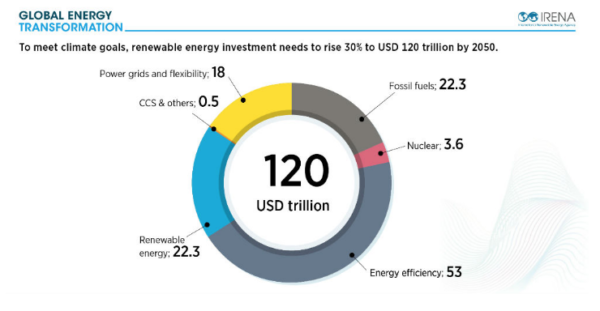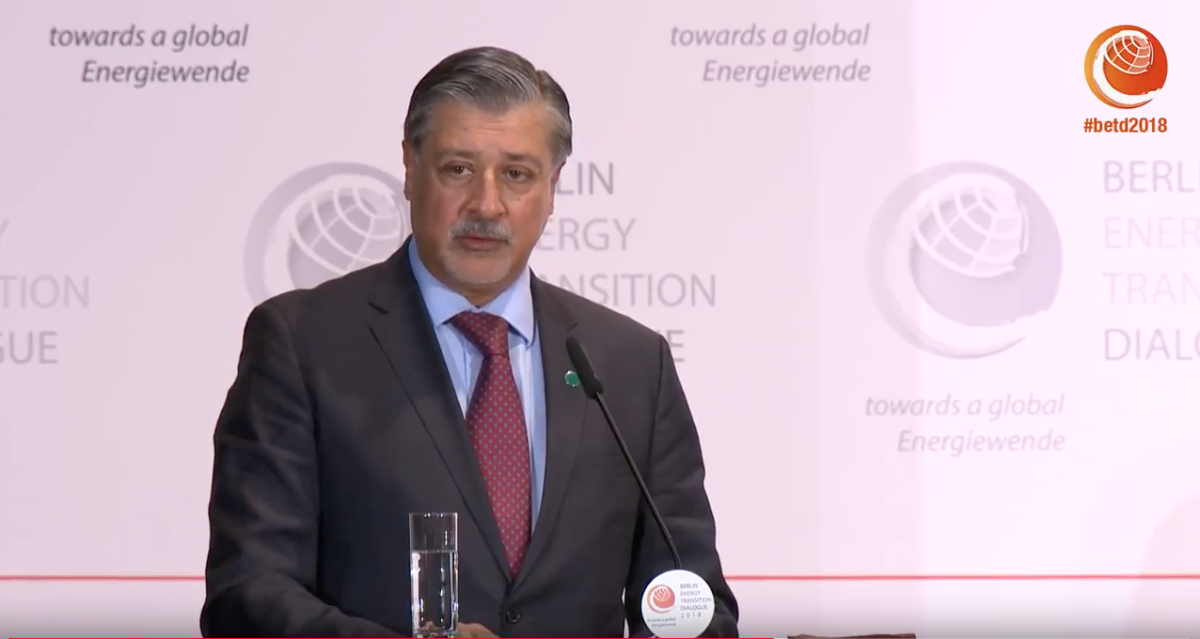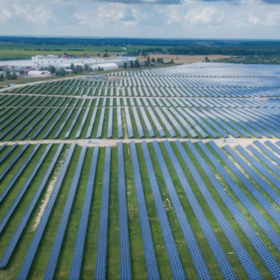Noting that current emissions trends are not on track to keep the temperature rise to well below two degrees celsius, the International Renewable Energy Agency (IRENA) says that immediate action is crucial, so that the world does not exhaust its energy-related “carbon budget” in less than 20 years, thus leaving enough room for fossil fuels to dominate the global energy mix.
Addressing the 4. Berlin Energy Transition Dialogue, IRENA Director-General Adnan Z. Amin said that for decarbonization of global energy to happen, renewables must account for at least two-thirds of total energy by 2050.
According to IRENA’s latest report Global Energy Transformation: A Roadmap to 2050 launched on the occasion, cumulative emissions must at least be reduced by a further 470 gigatons by 2050 compared to current and planned policies (business-as-usual).
This means that renewables need to be scaled up at least six times faster for the world to start to meet the goals set out in the Paris Agreement in a cost effective way, bringing economic, social and ecological benefits at national and global level.
Main pillars & risks
According to ARENA, the main pillars of the energy transition are energy efficiency and renewable energy, which together can reduce over 90% of energy-related CO2 emissions.
While the total share of renewables needs to rise to around two thirds by 2050, the energy intensity needs to fall by two thirds, lowering the total primary energy supply to slightly less than 2015 levels, says the report.
ARENA’s REmap case also suggests that renewables can make up 60% or more of many country’s total final energy consumption by 2050.

Meanwhile, procrastination to embark on energy transformation is seen as the key risk, and early action to channel investments in the right energy technologies is believed to be critical to reduce the scale of stranded assets.
The roadmap currently anticipates up to $11 trillion of stranded energy assets by 2050 – a value that could double if action is further delayed.
Greening the power sector
While significant progress has been made in recent years, ARENA suggests that the speed of progress needs to be accelerated.
Renewables saw a robust growth in 2017 of 8.3%, as the power sector added 167 GW of clean energy capacity, setting new records for solar and wind additions of 94 GW and 47 GW, respectively.
But in order to reach the Paris Agreement goals, the share of renewable energy in the power sector, which is at the core of the transition to a sustainable energy future, should increase from 25% in 2017 to 85% by 2050, mostly through growth in solar and wind power generation, states IRENA’s roadmap.
Costs, investments, jobs
Clearly, energy transformation would be cost intensive, but savings from reduced air pollution, better health and lower environmental damage would far outweigh these costs.
According to IRENA, the additional costs of the comprehensive, long-term energy transition would amount to $1.7 trillion annually in 2050, while savings in these three areas alone would average $6 trillion annually by 2050.
Moreover, the REmap Case shows that the energy transition stimulates economic activity, resulting in cumulative gain through increased GDP from 2018 until 2050 of $52 trillion.
Cumulative investment in the energy system between 2015 and 2050 would need to increase around 30% from $93 trillion according to the planned and current policies, to $120 trillion to enable the energy transition, with a bulk of it absorbed by renewable energy and energy efficiency, finds ARENA.

Another key benefit of the energy transition would be the employment boost in the energy sector. The report finds that while 7.4 million jobs in fossil fuels will be lost by 2050, 19 million new jobs will be created in renewable energy, energy efficiency, and grid enhancement and energy flexibility, for a net gain of 11.6 million jobs.
“Transformation will not only support climate objectives, it will support positive social and economic outcomes all over the world, lifting millions out of energy poverty, increasing energy independence and stimulating sustainable job growth,” said Amin, addressing the Berlin Energy Transition Dialogue.
“An opportunity exists to ramp up investment in low-carbon technologies, and shift the global development paradigm from one of scarcity, inequality and competition to one of shared prosperity – in our lifetimes. That is an opportunity we must rally behind by adopting strong policies, mobilizing capital and driving innovation across the energy system.”
The 2018 Berlin Energy Transition Dialogue will wrap up on Wednesday. pv magazine is at the event, and will bring you further reports from the show.
Author: Marija Djordjevic
This content is protected by copyright and may not be reused. If you want to cooperate with us and would like to reuse some of our content, please contact: editors@pv-magazine.com.








Difficulty lies in making countries across the globe agree on means and projects through which emissions can be controlled and generation through renewables augmented. The gap left because of US pullout from COP 21 is yet to be bridged. While realization of threat of Climate Change is visible, Countries are slow in corrective actions and bringing about policy changes mainly because luring investment is not easy.